Category — A Friday Visit with Jim Korkis
A Friday Visit with Jim Korkis DisneyBound by Leslie Kay
Welcome back to Fridays with Jim Korkis! Jim, the dean of Disney historians, writes about Walt Disney World history every Friday on yourfirstvisit.net.
YOUR PERSONAL DISNEY LIBRARY (37)
By Jim Korkis
- DisneyBound by Leslie Kay
I have been part of Disney fandom for decades and sometimes it is challenging to keep up with everything new that pops up and gathers a following.
When I was growing up, the big hobby was collecting Disney buttons, usually ones that were offered for free at Disneyland connected to special events or anniversaries. Fans traded or bought buttons through newsletters, conventions, on park visits and more. Today, I doubt whether anyone actively collects buttons although I still do when I can.
Let’s not forget Disney Beany Babies that sparked violence at Disney Stores and in the surrounding parking lots and was going to be a fan’s 401K plan. Or what about limited edition seri-cels that were going to be priceless in the future? In a way, they did become priceless since nobody seems to be able to get a decent price for them today, let alone recovering what it originally cost.
Those Disney fans investing heavily in pins, Vinylmation and Tsum Tsums today should remember that there is no intrinsic monetary value in any of them so the best advice is to collect what you enjoy and can reasonably afford.
I am also old enough to recall when Disney cosplay was born and fans dressed up in elaborate re-creations of Disney characters both human and animal for conventions. As a fan, vendor and guest at many a San Diego Comic Convention over the years, I saw that fascination grow in enthusiasm and improve in craftsmanship.
However, I was surprised when roughly nine years ago, a Disney fan named Leslie Kay asked herself the seemingly harmless question, “What would Rapunzel wear if she were a girl just like me going to the mall?”
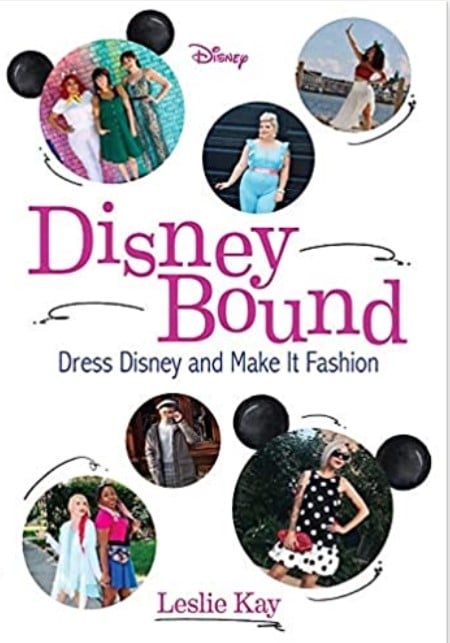
This is the first time in my life that I have ever described a book as “perky”, an obvious reflection of the spirit of the author. Interestingly, the book is an official release from Disney Editions and that gives it a seal of approval along with a foreword by Disney authority Jeff Kurtti, who confesses he was as clueless as I was when I first heard about Disney Bound.
Filled with colorful pictures of regular people and their creations, someone complained DisneyBound is just a scrapbook of her many friends, but I don’t see that as a flaw because it reinforces the fact that anybody can participate. All it takes is a little imagination and some cleverness, and nothing is more Disney than that. In addition, you can see the great joy on the faces of everyone included.
Besides the helpful “how-to” instructions, including the tip that small accessories can help complete the entire “look”, there are chapters devoted to individual characters like Minnie Mouse, Mr. Smee, Mulan and so many more, including a Dole Whip.
As I went through the pages, I was continually impressed with the thought and effort that went behind each outfit. I was also impressed that Disney Bound is also Disney “bonding” as a community that has developed around the concept and rather than being competitive, joy is shared by everyone.
DisneyBound serves as a fascinating documentation of this newer Disney phenomenon and as a wonderful introduction for those people who may be interested in exploring it, or are just a little curious.
* * * * *
Thanks, Jim! and come back next Friday for more from Jim Korkis!
In the meantime, check out his books, including his two new books, Vault of Walt Volume 9: Halloween Edition, and Hidden Treasures of the Disney Cruise Line.
Follow yourfirstvisit.net on Facebook or Twitter or Pinterest!!
February 26, 2021 No Comments
A Friday Visit with Jim Korkis: The Roses of Walt Disney World
Welcome back to Fridays with Jim Korkis! Jim, the dean of Disney historians, writes about Walt Disney World history every Friday on yourfirstvisit.net.
THE ROSES AT WALT DISNEY WORLD
By Jim Korkis
Walt Disney’s wife Lillian loved roses, and they were prominent in her home garden. They were one of the reasons Walt had to build an underground tunnel for his Carolwood Pacific railroad–so as not to disturb Lillian’s rose garden.
As a result, roses were prominent at Disneyland from its opening, and are in abundance at Walt Disney World.
The Rose Walk Garden at Epcot was initiated for the Epcot International Flower & Garden Festival in the 1990s, and was such a crowd pleaser that it was maintained year-round, although roses are cut back part of the year.
Another popular Walt Disney World location for roses is the lawn side wedding courtyard at Disney’s Yacht Club Resort. Roses and gardenias surround a gazebo, creating an intoxicating scent and just the right touch of romance for an outdoor wedding.
Unfortunately, with the expansion and redesign of the Hub at the Magic Kingdom in 2014, the beloved Plaza Rose Garden that had delighted guests with its beauty and tranquility since 1980 was removed.
A few of the first roses planted in that garden were All American Rose Selection 1980 winners Love, Honor and Cherish and 1981 winners White Lightning, Bing Crosby and Mariana. Over the years, the garden also displayed St. Patrick, All That Jazz, Betty Boop, Barbara Bush and Candelabra, just to name a few of the many roses that brought a smile to guests.
The garden was located between Cinderella Castle and the entrance to Tomorrowland. Many different species of roses could be found along the winding pathway that led to a covered area with benches that used to be the dock for the Swan Boats.
The garden was the recipient of the July 1985 All-America Rose Selections Inc.’s Public Rose Garden Award given for contributing to the public interest in rose growing through its efforts in maintaining an outstanding public rose garden.
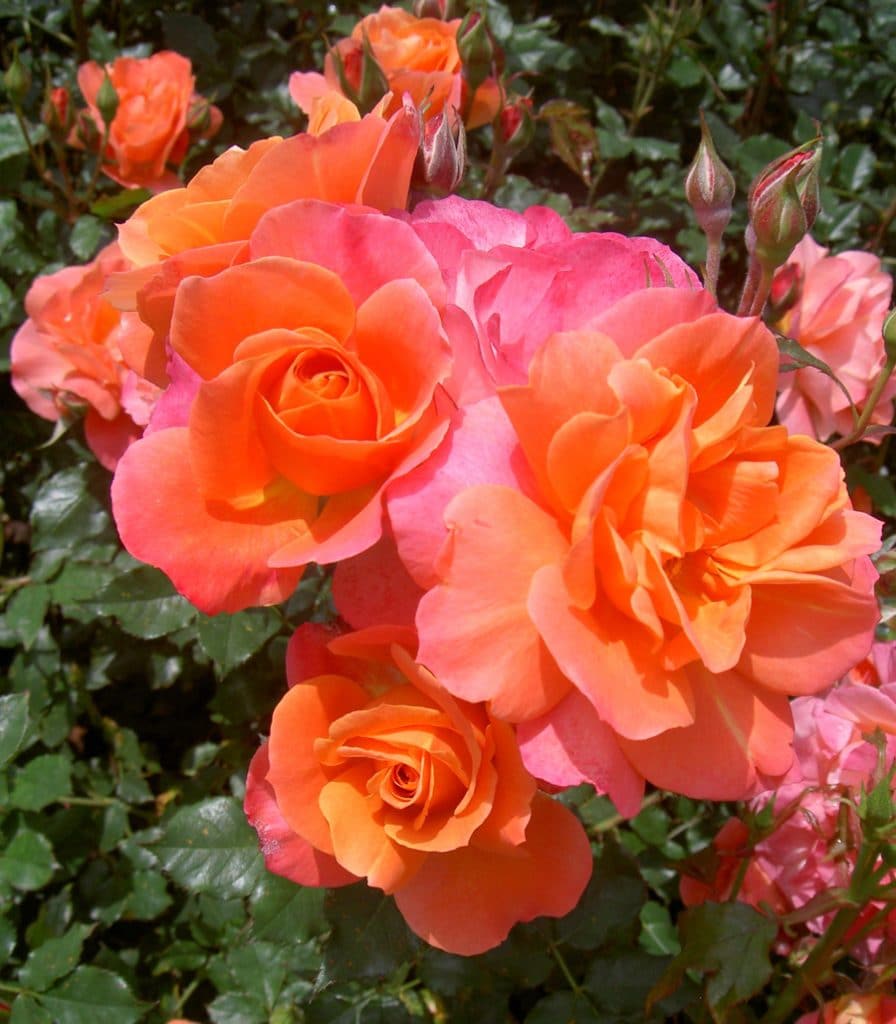
Disneyland Rose
(c) Disney
Shrub roses in different shades of pink were also on display in front of the castle, and old fashioned Louie Philip roses were in the broken planter in front of the Haunted Mansion. Those at Haunted Mansion challenge the gardeners to make the plants look neglected and overgrown.
The process of keeping roses pristine on property includes a soft-cut back in October and a hard cut-down in February or March, saving only four to six of the best branches for fertilization.
When it is warm again, the roses appear in full bud. A drip-line irrigation system is used to ensure that each root has its own water emitter with drainage at the base of the rose, as opposed to a traditional overhead irrigation system.
Walt Disney World garden specialist Allison Brooks said, “They like a well-drained environment in soil that doesn’t retain excess water at the base. They are sprayed weekly for pest control and with fungicide which helps also keep away those unsightly black spots and helps to keep them beautiful and romantic all the time.
“The rose is an easy flower to take care of, since you can plant it and let it grow with minimum trim. We are lucky in Florida, because it’s warm here most months, so the roses will bloom here throughout the year.”
Some of the myriad of rose varieties that can be found on Walt Disney World property include Hybrid Teas, Grandifloras and Floribundas. A particular Floribunda that can also be found is the Disneyland Rose.
Disneyland Roses were first bred in the United States in 2003 by Dr. Keith Zary in conjunction with John Walden. It was introduced to the general public the following year by Jackson & Perkins. Disney fans can purchase a Disneyland Rose directly from them.
This wonderful floral creation was the product of cross breeding the Hot Tamale rose with the rose Sequoia Gold. The result is an extremely colorful blend of orange and pink hues. Despite its beautiful color, it has only a slight fragrance, but what it does have is light and spicy. It continues to change color as it matures so it may start out apricot or copper in color.
* * * * *
Thanks, Jim! And come back next Friday for more from Jim Korkis!
In the meantime, check out his books, including his new books Vault of Walt Volume 9: Halloween Edition, and Hidden Treasures of the Disney Cruise Line.
Follow yourfirstvisit.net on Facebook or Twitter or Pinterest!!
February 19, 2021 No Comments
A Friday Visit with Jim Korkis: The U.S. Presidents at Walt Disney World
Welcome back to Fridays with Jim Korkis! Jim, the dean of Disney historians, writes about Walt Disney World history every Friday on yourfirstvisit.net.
US PRESIDENTS AT WALT DISNEY WORLD
By Jim Korkis
As we celebrate Presidents’ Day this month, I thought I would take a look back at American Presidents who visited Walt Disney World.
Since it opened in 1971, Walt Disney World has hosted every American President while they were in office, except for Gerald Ford and Donald Trump.
Ford did visit Disneyland in Anaheim in 1975, and his daughter Susan inaugurated River Country at Fort Wilderness Resort and Campground. Trump was scheduled to host a Republican fund raiser event at the Grand Floridian December 2019 but it was relocated to Miami.
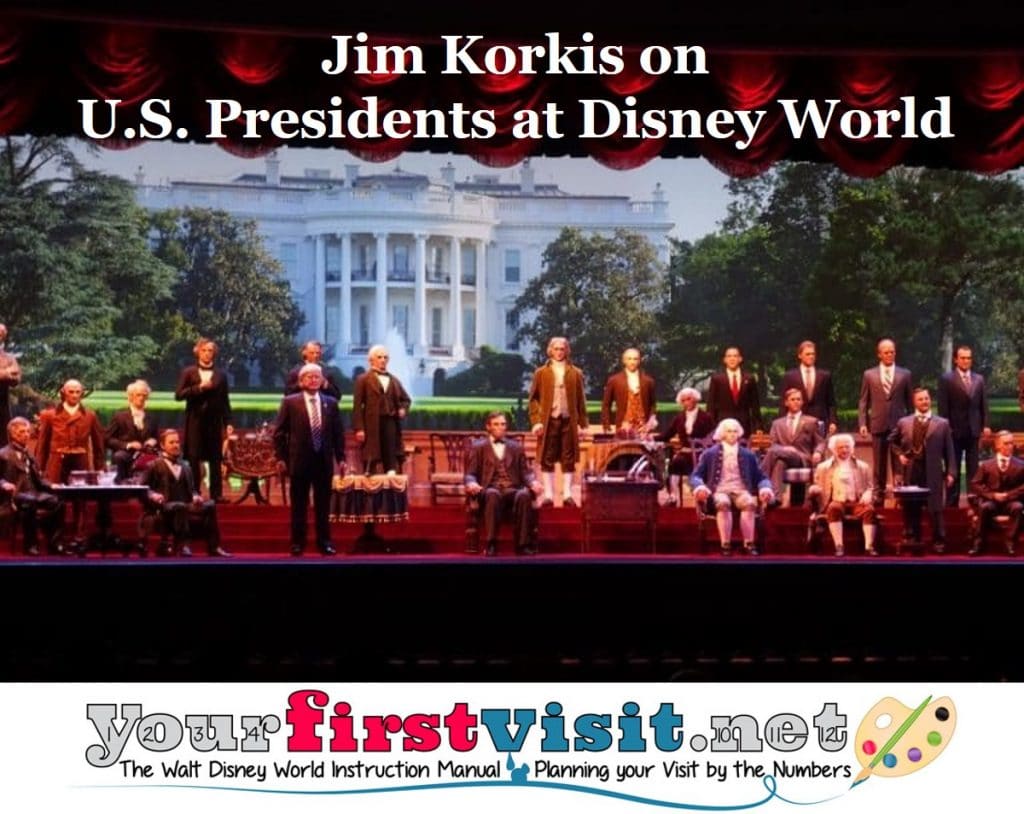
Jimmy Carter came to the Magic Kingdom in 1978, speaking from a podium decked out with flowers for the 26th World Congress of the International Chamber of Commerce.
Ronald Reagan made two trips to Epcot during his time in office, the first on March 7, 1983 when he visited the American Adventure. He viewed the attraction.
After the presentation, the President visited with students participating in the World Showcase Fellowship Program, an educational and cultural exchange program that no longer exists at Epcot, but was designed to enable outstanding young adults to represent their various countries for one year in the pavilions of World Showcase. That concept evolved into the College and International Program.
His second trip on May 27, 1985, was billed as the President’s Inaugural Bands Parade.
Dozens of marching bands were unable to perform at Reagan’s second inauguration because of severe cold weather. Disney CEO Michael Eisner, who was part of the viewing group in Washington, D.C., offered him the opportunity to have the bands perform for him at Epcot. Only eighteen of the original fifty bands were able to participate while Reagan observed from a special bulletproof plexiglass booth outside the American Adventure.
A star-and-striped costumed Mickey Mouse (who had previously posed for photos with the president, even giving First Lady Nancy a kiss on the lips) led off the parade with the combined Osceola and St. Cloud bands.
The bands were followed by a spectacular daytime fireworks display, the release of 15,000 balloons, and a flyover by four F16 fighter jets.
George H.W. Bush had two visits of his own to Epcot in 1990 and 1991. Walt Disney World’s 20th Anniversary Celebration was the setting for the first gathering of President Bush Sr.’s Daily Points of Light award recipients. This award is still given to outstanding community volunteers across the U.S.
It was held at the American Gardens Theater in EPCOT. President George W. Bush responded in kind in 2004 and named Walt Disney World itself a Daily Point of Light.
On January 19, 2012, Barack Obama gave a speech on travel and tourism set in front of Cinderella Castle at the Magic Kingdom, joking that: “I confess I am excited to see Mickey. It’s always nice to meet a world leader who has bigger ears than me.” In actuality, although Obama waved at the Partners’ Statue in Hub, he did not have a photo opportunity with a costumed Mickey Mouse.
At a later appearance in 2012, Obama spoke to the National Association of Latino Elected Officials conference held at the Contemporary Resort.
Even though both Bill Clinton and George W. Bush visited Walt Disney World property during their presidencies, they never actually went inside the parks. Bill Clinton just visited the Disney Institute in 1996 while George W. Bush delivered speeches at both the Contemporary Resort in 2003 and then the Grand Floridian Resort and Spa in 2006.
* * * * *
Thanks, Jim! There’s more on the (pre-President Biden) Hall of Presidents here.
And come back next Friday for more from Jim Korkis!
In the meantime, check out his books, including his new books Vault of Walt Volume 9: Halloween Edition, and Hidden Treasures of the Disney Cruise Line.
Follow yourfirstvisit.net on Facebook or Twitter or Pinterest!!
February 12, 2021 No Comments
A Friday Visit with Jim Korkis: Animation Hall at Disney’s Art of Animation Resort
Welcome back to Fridays with Jim Korkis! Jim, the dean of Disney historians, writes about Walt Disney World history every Friday on yourfirstvisit.net.
ANIMATION HALL AT ART OF ANIMATION
By Jim Korkis
Legendary Hall had been built to be the central check-in for The Legendary Years, the second half of the Pop Century Value Resort. The terrorism attack on September 11th resulted in a massive drop in travel and tourism, so Disney stopped construction on building more hotel rooms because there was a lack of demand.
Over the years, Disney announced at various times that it would finish the “ghost hotel,” but never did. In January 2010 Disney announced the resort would be re-themed into Disney’s Art of Animation Resort with construction beginning that summer.
Since much of the infrastructure was already in place, Legendary Hall was converted into The Animation Hall as a prelude to the animation experience in the four sections of the resort devoted to the animated films Finding Nemo, Cars, The Lion King and The Little Mermaid.
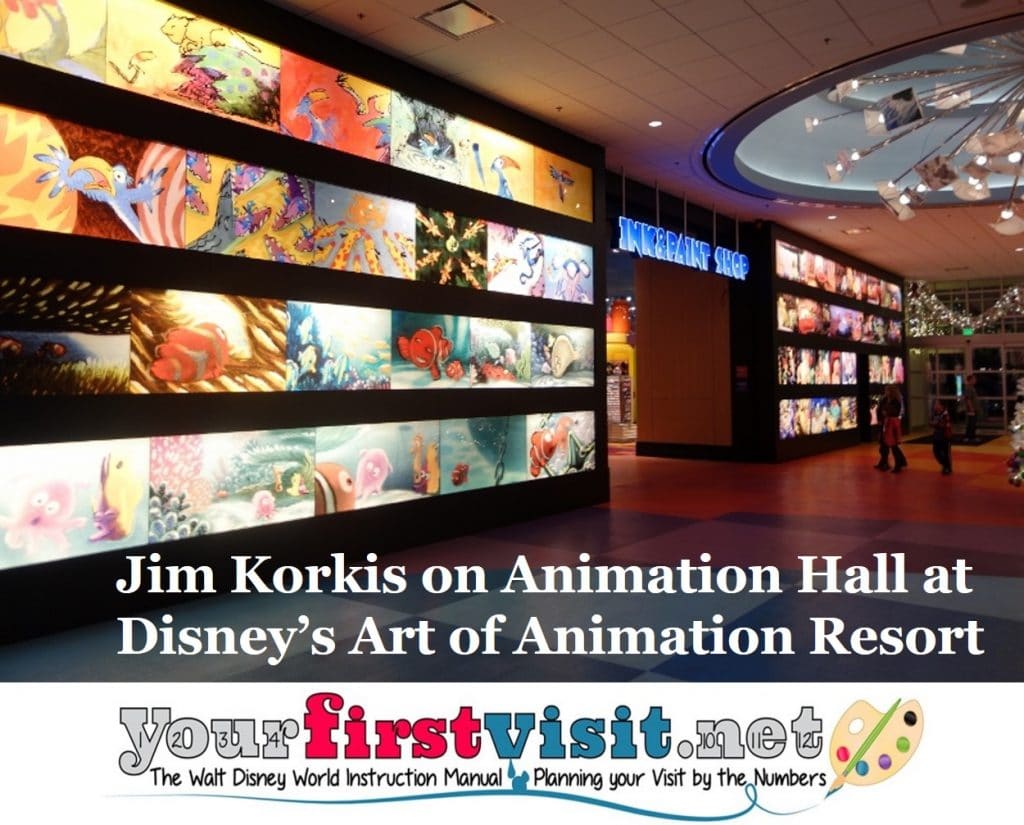
The examples on the wall opposite the check-in desk progress are enlarged from the actual original rough concept art of the characters from the four films represented at the resort to the final full-colored version, cleverly leading guests in the process to the Ink and Paint Shop and the Landscape of Flavors food court as well as the door leading outside to the various sections. The background music is a loop of music from the four films.
The end of the hall features the “storyboard chandelier” designed by the former head of Pixar animation, John Lasseter. The glass plates are examples of storyboard panels for an animated film and one of the drawings featuring Lightning McQueen was drawn and signed by Lasseter who directed the film Cars. When the resort opened, it was the only drawing that was signed in the hallway.
When the resort first opened, to reinforce the overall theme, those people working in the check-in area were not referred to as “cast members” but “concept artists”.
The back wall represents a color script used by animation artists to help determine the overall color palette for each scene which helps define the overall mood.
The Ink and Paint Shop’s wall fixtures are shaped like giant paint jars, arranged by color. Traditionally, specially mixed paint was once used to color the individual cels of an animated film. Today, the coloring is done digitally by computer.
Besides the usual items found in a shop at the WDW resorts, this shop is lined with art supplies up on the shelves and the walls. Paint brushes, colored pencils, and paper all represent the tools animation artists use in order to create a feature film.
Landscape of Flavors is the six hundred seat food court with an extensive variety of ever-changing offerings, divided into four sections to reference each of the four animated features represented at the resort. It features artwork of the environments of those films on the wall, painted ceiling light fixtures and more.
For instance, the ceiling fixture in the Lion King section simulates looking up through a jungle canopy while The Little Mermaid section has a painting of the grotto holding some of Ariel’s treasures that she has gathered.
* * * * *
Thanks, Jim! There’s much more on Disney’s Art of Animation Resort here.
And come back next Friday for more from Jim Korkis!
In the meantime, check out his books, including his new books Vault of Walt Volume 9: Halloween Edition, and Hidden Treasures of the Disney Cruise Line.
Follow yourfirstvisit.net on Facebook or Twitter or Pinterest!!
February 5, 2021 No Comments
A Friday Visit with Jim Korkis: StormStruck
Welcome back to Fridays with Jim Korkis! Jim, the dean of Disney historians, writes about Walt Disney World history every Friday on yourfirstvisit.net.
STORMSTRUCK AT EPCOT
By Jim Korkis
I’ve written a book entitled Secret Stories of Extinct Walt Disney World where I have over a hundred chapters devoted to things that have disappeared at WDW over the last fifty years. Of course, I barely scratch the surface of all the things that are gone–including this story, that does not appear in the book.
Opening in October 2009, StormStruck: A Tale of Two Homes in Innoventions East was a 4-D weather simulator experience with rain, hail, lightning, falling power lines and pine trees, shingles ripped off a garage roof and even a flying toilet.
In a small room holding twenty guests and lasting fifteen minutes, guests experienced what it was like in a home during a major hurricane.
After the show, under the guidance of a host, the guests were asked questions and were then given the option to make different choices from landscaping to architecture…whether Southern magnolias were better to plant in sand than pine trees, if doors that open out are better than doors that open in and if duct tape on windows really make a difference.
Then the experience was re-run with those new choices incorporated to see if they made a significant difference. It was announced the exhibit would only run for three years but was so popular that it was extended and finally closed in September 2016.
The exhibit was sponsored by FLASH, which stood for the Federal Alliance for Safe Homes. It was formerly the Florida Alliance for Safe Homes, which explains the “L” in the acronym.
Organizations involved with FLASH include insurance companies; manufacturers of building products that relate to disaster resistance (Simpson Strong-Tie, G-P Dens-Shield, etc.); product retailers like Home Depot; state agencies; the National Weather Service; FEMA; a few builders of disaster-resistant homes, such as Mercedes Homes; and the Salvation Army.
“We hope that guests walk away with a higher level of understanding on how to think about preparation to the next level for the protection of ourselves, our families and our community at large to ensure that on these rare occasions we can protect ourselves and recover,” said Jim MacPhee who was the vice president of Epcot when the exhibit opened.
It took seven years to conceptualize and complete the 3,000 square foot StormStruck exhibit.
Imagineer Joe Tankersley led the creation, direction and design of StormStruck.
“Doing that in a small space is a challenge, but we thought that raised the level of what we were doing here,” said Tankersley. “Our goal with all our Innoventions experiences is first of all to entertain people – we never forget that. We want to give them information they don’t have, to enlighten them and finally to empower them.”
President George W. Bush wrote in a letter read at the opening celebration, “this interactive attraction is an opportunity for people to experience the relentless winds and heavy rains of a hurricane in a safe setting. StormStruck also will help visitors to learn about the latest weather technology and inform them how to better prepare for these devastating storms.
“By encouraging Americans to be better prepared for emergencies and educating them about the danger of storms, you are helping our nation safe.”
The exhibit was especially interesting for Florida guests who lived on the Atlantic and Gulf Coasts of Florida and was a bit surprising and curious for those guests who were unfamiliar with the hurricane experience.
* * * * *
Thanks, Jim! And come back next Friday for more from Jim Korkis!
In the meantime, check out his books, including his new books Vault of Walt Volume 9: Halloween Edition, and Hidden Treasures of the Disney Cruise Line.
Follow yourfirstvisit.net on Facebook or Twitter or Pinterest!!
January 31, 2021 No Comments
A Friday Visit with Jim Korkis: Walk Around the Magic Kingdom Bricks
Welcome back to Fridays with Jim Korkis! Jim, the dean of Disney historians, writes about Walt Disney World history every Friday on yourfirstvisit.net.
MAGIC KINGDOM BRICKS
By Jim Korkis
In 2019, work began on removing the hexagonal bricks in the pavement at the Magic Kingdom entrance. Reasons included reconfiguring of walkways and tram loading and unloading zones, along with enhancements to security screening. The bricks were torn up, crushed, and recycled.
Those bricks were part of what was called the “Walk Around the World” that was originally meant to encircle the Seven Seas Lagoon. Originally, starting in 1994, guests could purchase a brick for two hundred and fifty dollars and have their name or some type of memory like a wedding anniversary date, birth of a child or first visit engraved on it.
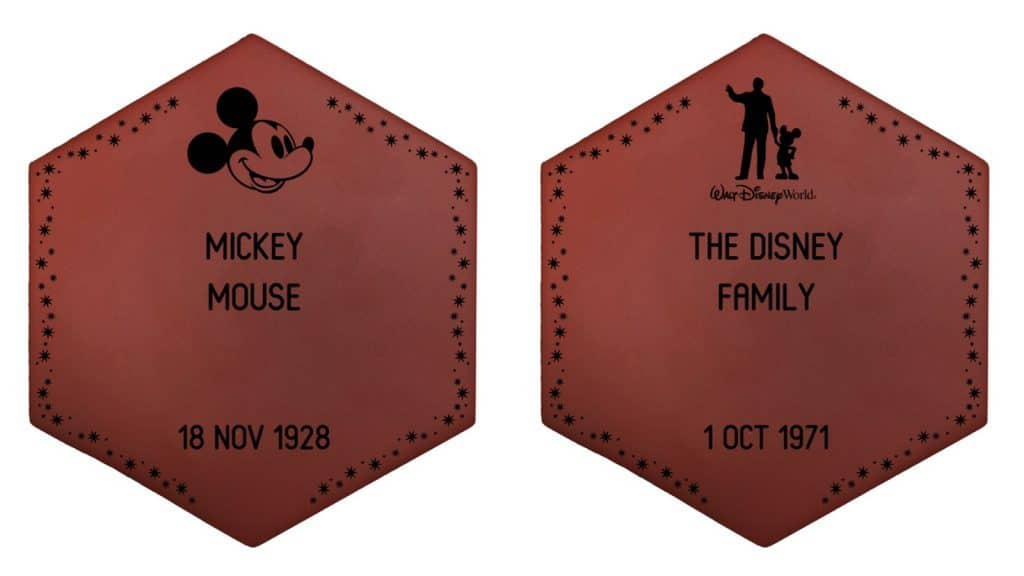
(c) Disney
There was the option of two to three lines of text (sixteen characters per line) and an image. Originally, the image was just a sideway silhouette of Mickey Mouse’s head (with the year inside it), but other images like wedding bells were later offered. Generally, most people just included their name, hometown and sometimes year.
The concept of personalized commemorative bricks right there in front of the Magic Kingdom was tremendously appealing even for those people like me who had very limited income at the time.
In those early years, I was able to get two bricks. One was at the entrance in front of the kiosks with just my family name and the date on it, and the other was by the pathway to the side of the monorail by a tree that had my name, the names of my parents, and the date of our arrival in Orlando from California.
While few guests read the fine print, Walt Disney World only guaranteed that once installed, the brick would remain for a minimum of ten years. The last bricks were sold in 2001 so by 2011 the guarantee had been more than satisfied.
One of the reasons for no longer selling bricks despite there being much more room available was to encourage guests to instead purchase a tile on the “Leave a Legacy” monolith garden at Epcot in front of Spaceship Earth that began in 1999 and were not initially selling well at all. That program ended in 2007 and those tiles have since been removed as well.
In addition, the contract specified that even though you paid for the brick and for installation, you did not actually own the physical brick. If it got broken or worn down, WDW would replace it with a blank brick.
The method for installing the bricks made it impractical to remove them individually without significant damage, but primarily logistics, timing and cost were major factors in not retrieving the original bricks.
Walt Disney World offered guests who purchased a brick a limited chance to buy a smaller six inch replica souvenir of it. Guests had to verify their brick at Guest Relations at Disney Springs or City Hall at the Magic Kingdom.
Guest Relations no longer had a complete list of the bricks, their inscription, or their location. When the original paver bricks were first offered for sale, there was a kiosk in front of the Magic Kingdom entrance where a guest could locate their brick and be given a map.
When a person purchased a brick, they were given a certificate with a code. For instance, a “W” indicated the brick would be west of the Magic Kingdom heading on the walkway towards the Grand Floridian. An “E” indicated the east side and “C” the Contemporary.
There were two numbers (also at the bottom of the brick) like “E16” to assist in locating it although the bricks were not always installed in order.
Currently there aren’t really any opportunities that allow guests to “be a part of the magic” by having their name or likeness displayed in or near the parks.
* * * * *
Thanks, Jim! And come back next Friday for more from Jim Korkis!
In the meantime, check out his books, including his new books Vault of Walt Volume 9: Halloween Edition, and Hidden Treasures of the Disney Cruise Line.
Follow yourfirstvisit.net on Facebook or Twitter or Pinterest!!
January 22, 2021 No Comments


